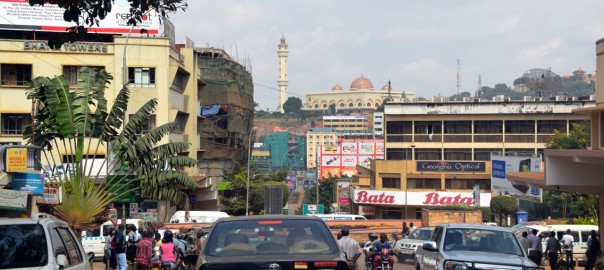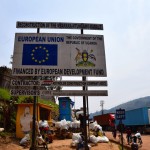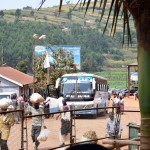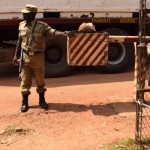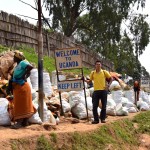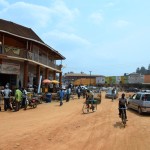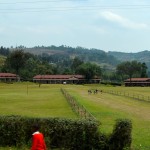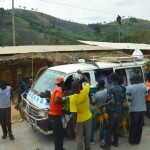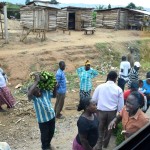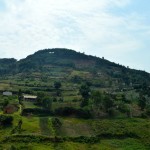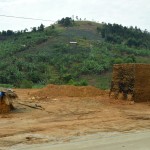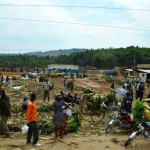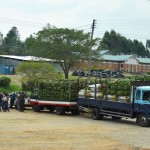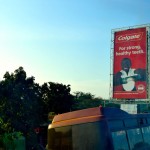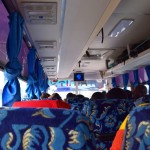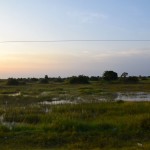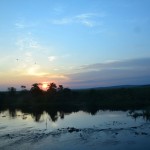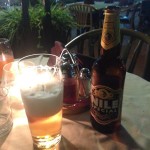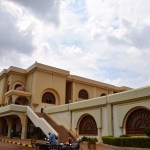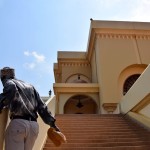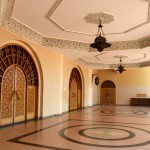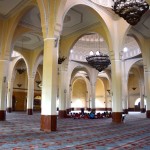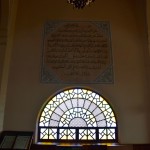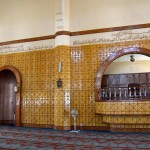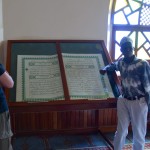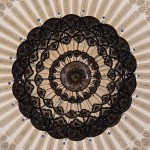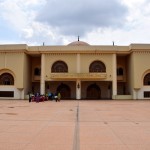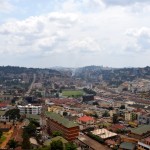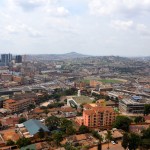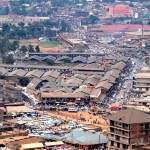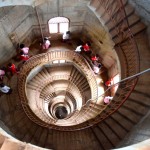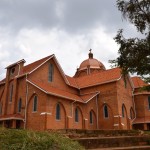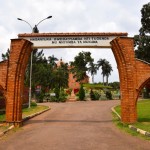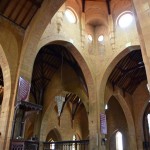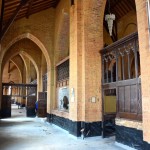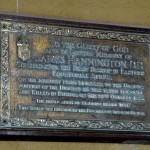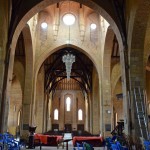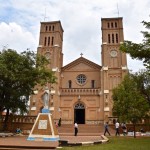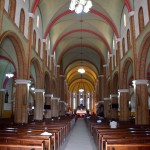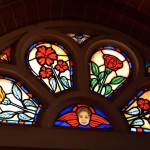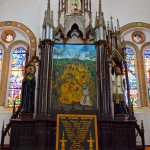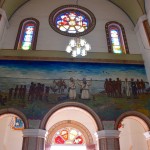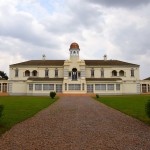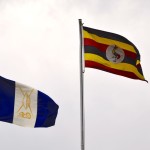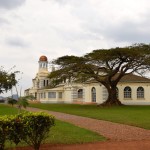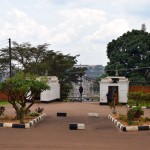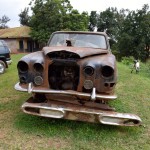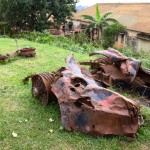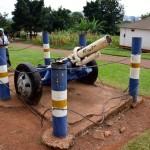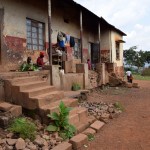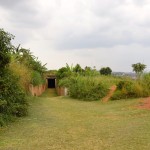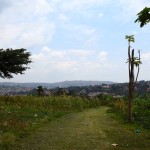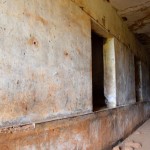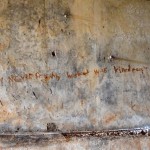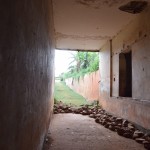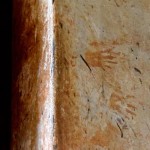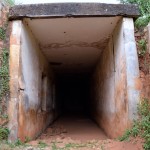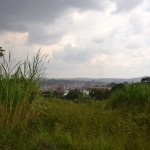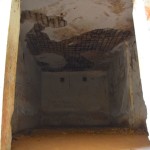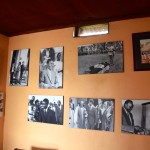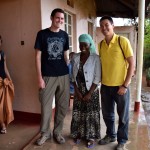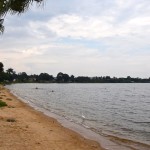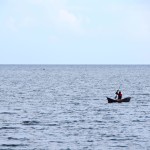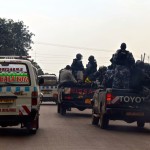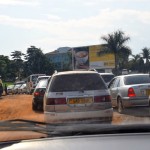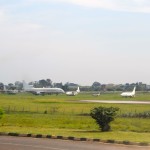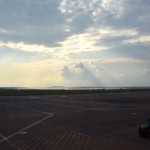Continuing from Rwanda on the Africa segment of The Great Eastern Summer, we arrive in Kampala, Uganda where we encounter prostitutes, visit churches and mosques and explore the torture chambers of Idi Amin. On the following day we stop by Lake Victoria before leaving from Entebbe.
After a depressing visit of Rwanda, Bill and I were on a bus crossing the border into Uganda. The immigration process was quite straightforward. We went through a checkpoint on the Rwandan side that gave us our exit stamp then walked across a bridge separating the countries and lined up on the busy Ugandan side. An AK-47 armed police officer ushered large transportation trucks that stirred up dry yellow dirt into the air as they drove by us waiting for our entry stamp.
Country 78 complete.
Eventually our bus made it through the immigration check and drove into Uganda, switching sides on the road which was interesting. We boarded for the long bus ride to Kampala.
This was a lot of road construction to pave a pothole filled road slowing down our journey. At least this bus was fairly comfortable with four seats per row.
We passed many small towns but only stopped once at a gas station where passengers disembarked for food and snacks.
The entire bus ride was almost 10 hours including the 1 hour time difference. We arrived in Kampala at 8:30 p.m. at an empty bus terminal on the outskirts of the city. We wandered through the dirt parking lot and bargained with a taxi to take us to Speke Hotel.
On the drive over I asked the driver what are the famous sights of Kampala and he pointed at the numerous street walkers which we passed every 10 feet. They were starting their shift for the evening. He continued to explain that these girls are the most famous thing to see in Kampala.
BUT you must be very careful… all of these girls have AIDS.
Really?
Yes, they all have AIDS here. It is a big problem. You must use condom.
We weren’t really planning on indulging on the prostitutes of Uganda, but we appreciated the taxi driver’s heartfelt tip.
After checking into one of the oldest hotel’s of Kampala. After we settled in, we went for a brick-oven baked pizza and local beer at the in house Italian restaurant.
Prostitutes of Kampala
Then we went to check out the nightlife at the hotel bar. The large outdoor bar was more like a club with the loud beats and flashing lights. Men crowded the bar areas while girls in miniskirts danced and played pool. Before we even walked to the end of the bar two girls approached us and introduced themselves. They held out their hands and we reluctantly shook them. As our skin touched, the one thing on my mind was AIDS.
The two girls were early to mid twenties and wore skirts matched with flashy tops. They both spoke English quite fluently and asked us to sit and chat, which we refused. One claimed to be a student while another was a model, but before the end of the conversation their careers changed several times. One thing I noticed about prostitutes is that they can never keep their stories straight.
Another girl joined us and looked to be in pretty bad shape with temporal wasting around her temples.
Though we had no interest in sitting with these girls, they did provide some interesting conversation. They feared Kampala was going to be bombed because of the governments recent participation in Somalia. They also talked about the nightlife in the city and reaffirmed that girls were the best sights in Kampala.
When they realized that we were not going to succumb to their advances, they left to stalk new prey.
And that was our signal to leave. We walked back to the main entrance of the hotel, passing by several foreigners sitting with local girls with busy hands. Other working girls yelled at us to join them at their tables.
We returned to the room and washed our hands.
Top Sights of Kampala
The next morning we were off to check out the main sights of Kampala. We hired a driver for the day and started with the religious buildings.
The Uganda National Mosque, previously called Gaddafi National Mosque because it was commissioned by Gaddafi of Libya as a gift to the country. Recently built in 2006, the massive mosque can hold close to 20,000 worshipers and is located on one of the hills of Old Kampala.
After we paid the entrance, a guide led us on a tour through the mosque. This eccentric guide read and translated some Islamic scripture for us and commented on foreign religions and beliefs. A primary school trip was also underway in the mosque with dozens of children in uniforms running around the carpeted halls.
We left the tour as it was taking too long and climbed to the top of the minaret for some excellent views over the city.
Our next stop was Namirembe Cathedral, also known as Saint Paul’s Cathedral Namirembe, which is the city’s main Anglican Church and the first cathedral of Uganda founded in 1890.
On entering the grounds, a guard at the gate stopped our car and thoroughly went through my bag and even made me open a small case containing my laptop charger. He said it could be a bomb…
We walked through the church which was under renovation, but strangely still allowed visitors.
We then drove to the neighboring hill where Rubaga Cathedral was perched. Saint Mary’s Cathedral Rubaga is the oldest and main Roman Catholic church of the country, completed in 1925.
Guides waited to take visitors around the church. There were interesting stained glass designs and a memorial to the Uganda Martyrs.
Our last stop in the city was Mengo Palace, the royal property that contains the infamous torture chambers of Idi Amin. Built by Kabaka, the king of Buganda the original palace was destroyed in 1966.
We walked through the security check with a metal detector and went into an office to buy tickets (5,000 shillings) and meet our guide. She was very friendly but had a strong accent that was difficult to understand at times.
She showed us the Palace, which no one could enter unless they were part of the royal family, guard, or entourage. The current king lives in a different palace outside of the city center.
Then we walked by two Rolls Royces that previously belonged to Idi Amin and were destroyed and buried after he was ousted. They were dug up and put on display. A goat was tied to a stake next to the car eating grass.
Our guide showed us the blue and white cannon that Idi Amin brought with him when he took power. While the former president was in Singapore, Idi Amin a general at the time, just rolled into the palace with his cannon and told the president not to come back or he would be killed.
The land of the palace now also house government workers. Much of the palace grounds have been turned into farmlands so that the workers’ families can farm and make use of the otherwise idle land.
We saw the shacks that the families lived in while chickens, goats, and other animals wandered about the palace enclosure.
Our bubbly guide led us through the fields of corn and other crops towards the torture chambers.
From the outside the chambers look nothing more than a storage facility or parking garage. In fact it was originally built as an armory, but as Idi Amin lost support and power, he transformed the rooms into torture chambers for anyone of suspect.
These 10 by 10 feet cells held four hundred prisoners at a time with an opening to a hallway floor that was filled with electrified water, so those trying to escape would be electrocuted.
Prisoners were moved to the cell in the end of the hall for execution, suffocated in the crammed cells, or died of disease and starvation. The surviving prisoners often had to move and bury the bodies of those deceased.
Within 8 years of Amin’s rule an estimated 100,000 to 500,000 people were killed.
After Amin the former president who took power again, continued to use the space as a torture chamber.
Our guide said that the security guard that checked us on entering has been in his position since before Amin’s rule, so he has seen the trucks full of prisoners enter the compound and leave empty.
The walls of the small hall and chambers were covered with messages and handprints, a grisly reminder of the recent past.
To complete the tour we returned to the office where another guide gave us a history lesson of the country with pictures of the recent leaders.
Then we left Kampala and drove towards the airport in Entebbe. On the way we made a stop at Lake Victoria where locals paddled around in canoes and played in the water. I also picked up my country tourist shirt.
Entebbe International Airport had some of the strictest security I’ve ever encountered. Each car was emptied of passengers and was checked by a security crew while the passengers went through a separate security check. A traffic line formed waiting to get through the first checkpoint. They seriously are worried about a potential terrorist bombing.
There were large UN tents within the gated airport as well as UN check-in counters. We went through the process and soon boarded our flight to Qatar!
What an intensive journey through Africa!
